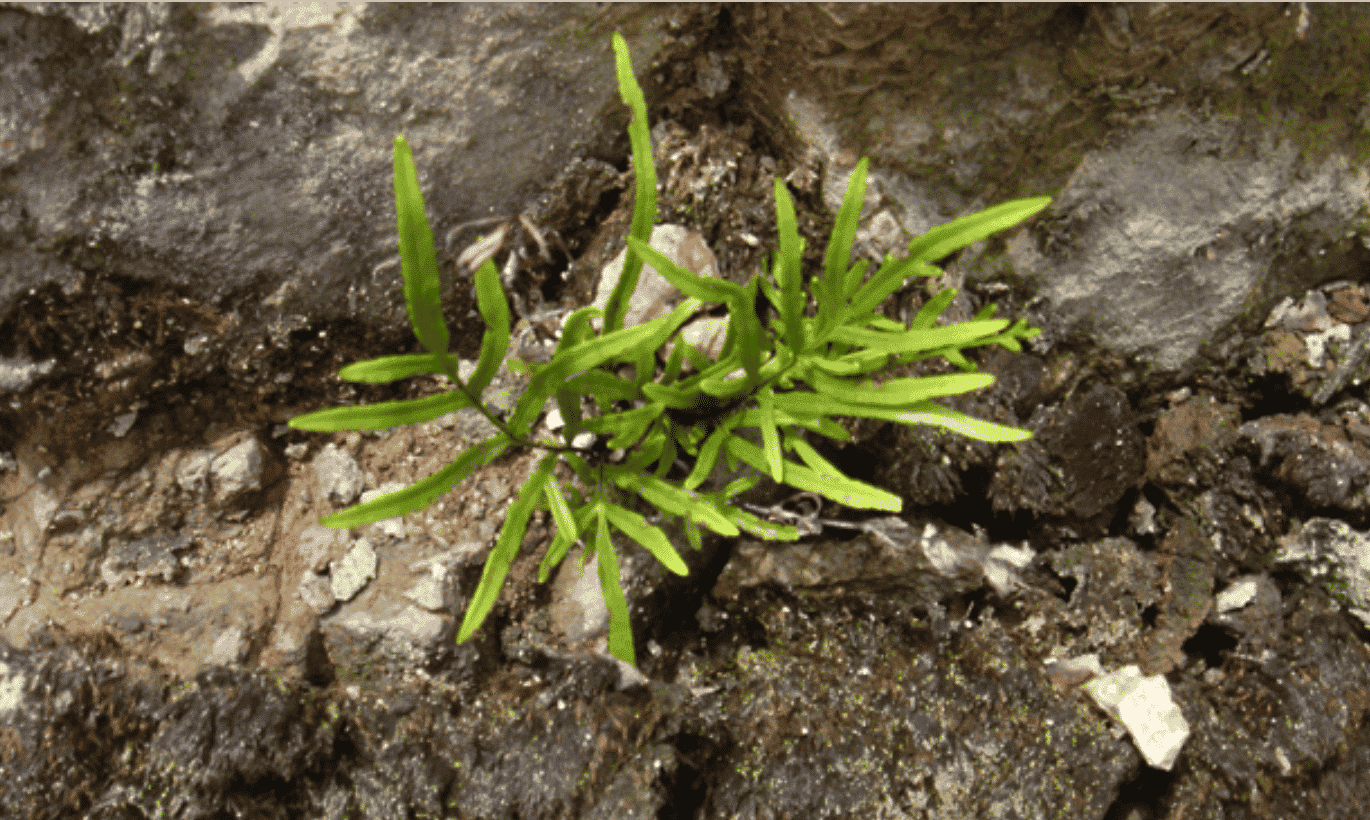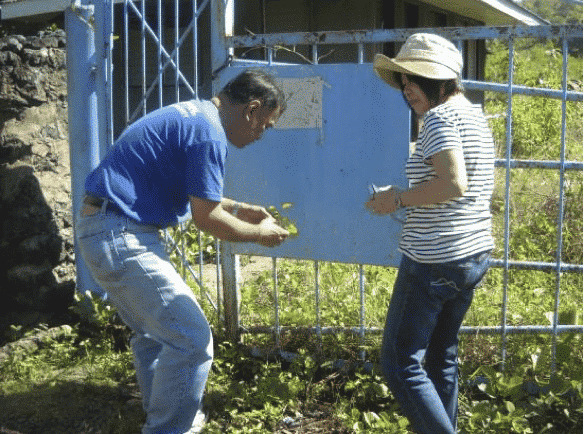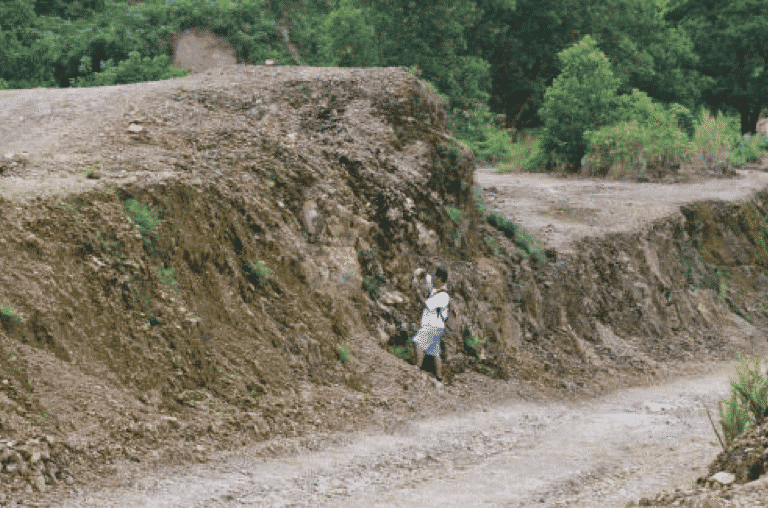
This Fern Is Absorbing Arsenic, Copper From Toxic Mining Soil in the Philippines

The Pteris melanocaulon thrives in abandoned areas after an open pit copper mining operation. Mary Jean Apuan / Mongabay
Filipino scientists have discovered what might be the next big indigenous plant material for rehabilitating a mining site teeming with copper and arsenic — and it’s a largely ignored local fern.
Published in the peer-reviewed journal Chemosphere, the study by a group of scientists led by Rene Claveria of the Ateneo de Manila University records the unique ability of Pteris melanocaulon to absorb copper in its roots and arsenic in its leaves in large doses.
“It’s not common for ferns to absorb both high concentrates of copper and arsenic,” Claveria, an environmental geology expert, tells Mongabay. “Plants don’t do it simultaneously in large doses. It’s something new.”
The fern was spotted in the mossy areas of an abandoned mining site in the province of Surigao del Norte by the scientists scouring major mining sites across the Philippines to study copper metallophytes under a government-funded research program.
The study of metallophytes, plants that have the ability to thrive on soils with high concentrations of heavy metals that are too toxic for other plant species, has been a growing interest among scholars, particularly for their possible use in phytoremediation, the process of cleaning up mineral-rich soil and groundwater using plants and trees.
“It’s not common for ferns to absorb both high concentrates of copper and arsenic,” Claveria, an environmental geology expert, tells Mongabay. “Plants don’t do it simultaneously in large doses. It’s something new.”
The fern was spotted in the mossy areas of an abandoned mining site in the province of Surigao del Norte by the scientists scouring major mining sites across the Philippines to study copper metallophytes under a government-funded research program.
The study of metallophytes, plants that have the ability to thrive on soils with high concentrations of heavy metals that are too toxic for other plant species, has been a growing interest among scholars, particularly for their possible use in phytoremediation, the process of cleaning up mineral-rich soil and groundwater using plants and trees.

A fern species that flourishes in the mossy slopes of an open pit copper mining site in Surigao del Norte, a province in Mindanao. Teresita Perez / Mongabay
“We are interested in metallophytes … plants that grow on mining areas,” Claveria says. “While analyzing all these plants, we decided that fern is the most suitable for our study because they have higher amounts of absorbed copper and arsenic and other metals.”
The decision to narrow down to ferns came with scholarly backing: the Pteris genus, which includes around 300 species of ferns, feature other popular metallophytes that absorb arsenic. But unlike other widely researched species, P. melanocaulon was mostly unknown, in part due to the scarcity of research journals on the plant. Existing surveys conducted by the team across various large- and small-scale mining sites showed that it only proliferates in two areas in the Philippines.
“When we focused on ferns, there was one that stood out: the P. melanocaulon, which we didn’t see in any other mining sites we surveyed,” Claveria says. “We found it in Surigao [del Norte] and later on, in Carmen [in Cebu province] … and this fern happens to grow in areas [within these sites] that are supposedly barren.”
The mossy open slopes left behind by open pit mines, notorious for their high levels of arsenic and copper concentrates, were the perfect breeding grounds for P. melanocaulon, which thrive in lush clusters that overpower the other plants in the Surigao del Norte mining site, Claveria says. Curious about the fern, they recovered samples and conducted initial tests to measure its copper absorption capabilities in 2014.
The results showed that the plant’s roots have “anomalously high” concentrations of copper, Claveria says. After publishing their findings in the International Journal of Phythoremediation in 2015, the team expanded their research on the plant and threw arsenic into the mix.

Rene Claveria and Teresita Perez examining plants in Surigao del Norte. Teresita Perez / Mongabay
The logic was since the fern survives alongside other species that are known arsenic metallophytes, maybe it could also absorb arsenic.
After collecting another set of samples, they conducted a series of tests that verified their hypothesis: the fern does indeed absorb the toxic mineral and stores it in its stems and leaves. They took the research a little further and funded a greenhouse to propagate spores of P. melanocaulon at Xavier University in Cagayan de Oro province, where they experimented with the potted plants.
They added different concentrations and solutions of arsenic to uncontaminated soil in a series of experiments that lasted for six weeks. The plant’s ability to absorb arsenic varied, adjusting to the concentration of the element in the soil, much to the researchers’ surprise. The team noted two important observations: that the fern contained more arsenic concentrate than the soil it was planted on, and that despite exposure to high levels of arsenic, it showed no symptoms of toxicity.
“P. melanocaulon is an accumulator of [arsenic], with the plant having higher amounts of [arsenic] than that of the soil,” the study says. The study also noted that while the arsenic concentration increases, the fern can “efficiently absorb and store” arsenic and extract it from the soil, making it an “efficient arsenic accumulator and hyperaccumulator.”
The results, according to Claveria and Teresita Perez, also of the Ateneo de Manila University who headed the research program, prove that the plant can be used to rehabilitate mining sites, especially since its “root system provides good soil cover” and “can ideally immobilize metal contaminants.” This means that the plant can filter contaminated water and reduce the spread of heavy metals through the soil.

Rene Claveria collecting soil samples in Surigao del Norte. Teresita Perez / Mongabay
“If you use the ferns to clean up arsenic, which is very toxic, there could be colonization or succession of plants,” Perez says. “Eventually, a year after or after one and a half years, you can already plant some high value crops in the area.”
With the protocol in the propagation of the fern species in the books, Perez says the possibility of using the fern to rehabilitate mining soil on a large-scale project is possible. But first, she says, decision-makers should be aware of metallophytes — and that there are indigenous plants that can be used as natural remedies to alleviate mineral-heavy soils.
“We have to recommend to our policymakers the use of indigenous plant materials to actually clean up arsenic-contaminated areas,” Perez says. “In the past, rehabilitating mining sites involved planting invasive species — that was really a wrong move. But now, we’re propagating the idea of indigenous and endemic species so these areas can develop new ecosystems.”
Reposted with permission from Mongabay.
- Tribes Halt Major Copper Mine on Ancestral Lands in Arizona ...
- This World War I Battlefield Is a Haunting Reminder of the ...
- Toxic Metals Found in 95 Percent of Baby Foods - EcoWatch
- Swedish Toxic Waste Poisons Chilean Community for 30 Years ...
- Russian Mining Giant Admits to Polluting the Arctic With Wastewater - EcoWatch
- Tree Ferns Are Among the First to Recover After Wildfires
- Toxic and Radioactive: The Damage From Mining Rare Elements

 233k
233k  41k
41k  Subscribe
Subscribe 